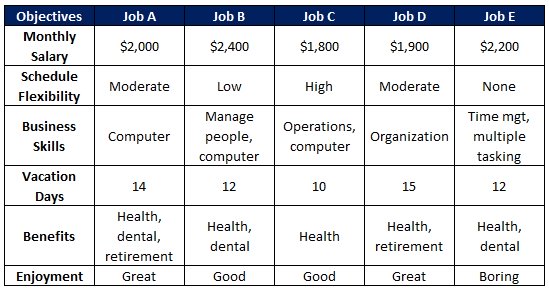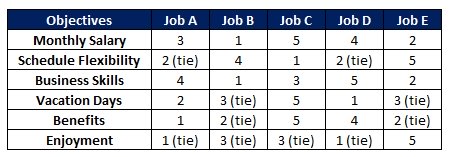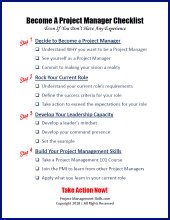PrOACT Decision Making Model
The PrOACT decision making model provides a systematic approach for making decisions. It consists of eight elements that will help you make better decisions when worked through systematically.
The PrOACT decision making model was developed by John S. Hammond, Ralph L. Keeney, and Howard Raiffa. They
described how to make a decision using the PrOACT model in the book Smart Choices: A Practical Guide to Making Better Decisions.
The term PrOACT is an acronym of the five core elements of the decision model...
- Problem
- Objectives
- Alternatives
- Consequences
- Tradeoffs
The remaining three elements help clarify decisions in volatile or evolving environments...
- Uncertainty
- Risk Tolerance
- Linked Decisions
Let's take a look at each of the elements of this decision making model.
PrOACT Decision Making Model Elements
Problem
The first step to making a good decision is to work on the right decision problem.
The way you frame your decision problem drives everything else in the decision making process. It determines the alternatives you consider as well as the way you evaluate them.
"A good solution to a well-posed decision problem is almost always a smarter choice than an excellent solution to a poorly posed one."
Objectives
Once you've framed your decision problem, it's time to specify your objectives.
Why is this important? Because your objectives will form the basis for evaluating your alternatives. In other words, they become the decision criteria.
In addition to making sure your decision gets you where you want to go, objectives also guide the decision making process...
- Objectives help you determine what information you need
- Objectives help you justify your decision to others
- Objectives determine a decisions importance
Alternatives
In order to make a decision you need to have alternatives to decide upon. It's important to spend some time to create imaginative alternatives. You want to have a wide range to choose from, so don't limit yourself here, get creative. Remember...
"You can never choose an alternative you haven't considered."
However, you also want to make sure the alternatives you've generated are good. Regardless of how many alternatives you have, your decision can only be as good as your best alternative.
Here are some tips from Smart Choices for coming up with a good set of alternatives...
- Use Your Objectives - Ask "How?"
- Challenge Constraints
- Set High Aspirations
- Do Your Own Thinking First
- Learn from Experience
- Ask Others for Suggestions
- Give Your Subconscious Time to Operate
- Create Alternatives First, Evaluate Them Later
- Never Stop Looking for Alternatives
Consequences
Once you've generated the alternative open to you, you need to understand the consequences each alternative would have for each of your objectives.
Using a consequences table is a simple and powerful way to compare the alternatives.
 PrOACT Decision Making Model Consequences Table - Source: Smart Choices
PrOACT Decision Making Model Consequences Table - Source: Smart ChoicesWhen creating your consequence descriptions, it's important to make sure they are accurate, complete, and precise. Otherwise, you risk making a poor choice.
Tradeoffs
Many times, objectives will conflict with each other. As a result, you will have to evaluate tradeoffs between the objectives. You will need to sacrifice something from one objective to gain something from another objective.
You can begin to consider tradeoffs by ranking the alternatives for each objective. This can be done using a ranking table. A ranking table is structured the same way as a consequence table, but instead of noting consequence descriptions, you put each alternatives rank relative to each other for that objective.
 PrOACT Decision Making Model Ranking Table - Source: Smart Choices
PrOACT Decision Making Model Ranking Table - Source: Smart ChoicesA ranking table will often enable you to eliminate some of the alternatives outright. In fact, it sometimes even leads directly to the final decision.
Uncertainty
Since most business decisions don't happen in a static environment, it's important that you clarify your uncertainties. To make a good decision you need to judge the likelihood of different outcomes and assess their possible impact.
A risk profile will help you capture the key information about how an uncertainty affects a specific alternative. A risk profile will answer these four key questions...
- What are the key uncertainties?
- What are the possible outcomes of these uncertainties?
- What are the chances of occurrence of each possible outcome?
- What are the consequences of each outcome?
Often, creating the risk profiles will make the smart choice obvious. But some complex decisions may need further analysis to clarify the uncertainties. In these cases, a decision tree can help you make a decision under uncertain conditions.
Risk Tolerance
When decisions involve uncertainty, there's always a chance that the desired consequence of your decision will differ from the actual consequence. As a result, it's important that you determine your risk tolerance.
Risk tolerance is the extent to which you are willing to risk experiencing a less favorable consequence in your pursuit of a better consequence.
There are three steps you can take to incorporate risk tolerance into your decision...
- Think hard about the desirability of each consequence
- Balance the desirability of the consequences with their chances of occurring
- Choose the most attractive alternative
Understanding your willingness to accept risk will help you choose an alternative with the right level of risk for you.
Linked Decisions
The decisions you make today will influence the decisions you make in the future. These are called linked decisions. To make your best decision about what to do today, you need to consider linked decisions.
There are six basic steps for analyzing linked decisions...
- Understand the basic decision problem
- Identify ways to reduce critical uncertainties
- Identify future decisions linked to the basic decision
- Understand relationships in linked decisions
- Decide what to do in the basic decision
- Treat later decisions as new decision problems
Understanding how decisions are linked combined with a little foresight will help you make better choices.
In Conclusion...
The PrOACT decision making model is an excellent framework for guiding your important decisions.
For more information, I highly recommend you get a copy of the book Smart Choices. It provides excellent case studies and many more decision analysis tools that can help you improve your decision making skills.
Related Articles About Decision Making Models
Decision Making Skills and Techniques
Decision making skills are critical for business success. Learn which decision making model is right for your situation. The quality of your decisions will determine your effectiveness.
Do You Want More Project Management Tips?

Subscribe to Project Success Tips, my FREE Project Management Newsletter where I share tips and techniques that you can use to get your Project Management Career off to a great start.
As a BONUS for signing up, you'll receive access to my Subscribers Only Download Page! This is where you can download my "Become A Project Manager Checklist" and other project management templates.
Don't wait...

New! Comments
Have your say about what you just read! Leave me a comment in the box below.